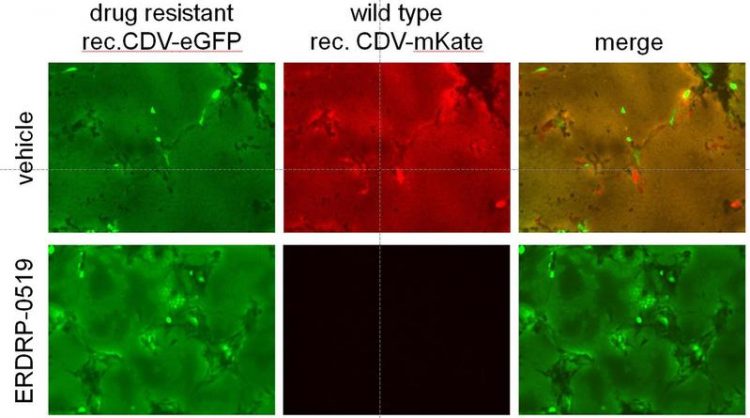Measles – new active ingredient may have a protective effect against local outbreaks?

Cells infected with drug-resistant (green fluorescence) and wild type (red fluorescence) recombinant canine distemper virus. Infected cells were treated with ERDRP-0519, or received solvent only Foto: Georgia State University
Despite world-wide efforts to eradicate the disease, measles outbreaks still occur time and again among the German population due to incomplete vaccination rates. In 2013 alone, 1775 measles cases in Germany were reported to the Robert-Koch-Institute. Against this background, an inhibitory substance would be helpful which protects the patient after an infection with the virus and reduces the risk of further spreading of the virus.
Professor R. Plemper of the Institute for Biomedical Sciences, Georgia State University, Atlanta, USA, and colleagues have developed a low-molecular inhibitory substance against the measles virus, which is available for oral administration and could be administered in tablet form. The active substance, called ERDRP-0159, inhibits RNA-dependent RNA polymerase, which is indispensable for the replication of the virus.
Up to now, the development of a suitable inhibitory substance against virus has barely been possible because a suitable animal model for efficacy testing was not available. Dr Veronika von Messling, head of the Veterinary Medicine Division of the Paul-Ehrlich-Institut, and colleagues have succeeded in establishing an animal model in the ferret for this purpose. This project forms part of the institute’s involvement in the German Centre for Infection Research (DZIF).
The research group used a very close relative of the measles virus, the canine distemper virus (CDV) for their experiments. Like the measles virus, this virus belongs to the family of morbilliviruses. An infection with this virus will lead to fatal outcome in ferrets. However, if the animals were treated with the inhibitory substance for 14 days as from the third day after the infection, all ferrets survived the virus infection. Besides, the treatment, which was very well tolerated by the animals, conferred the development of immune protection against the measles virus. A new infection with the virus did not cause disease.
The most important obstacle to be overcome in the development of medicines against viruses is that the virus frequently develops resistance. Experiments with some virus variants showed that the infectious disease induced by them was attenuated or the course of the infection was slowed down. Dr Messing explains the results: “Our experiments allow us to forecast that such resistance development would not spread among the population – especially based on the fact that the measles outbreaks are as a rule locally restricted because the major part of the population has been vaccinated”.
The results obtained so far give rise to optimism. However, there are still some important questions to be answered. Thus, it must still be established whether treatment with the inhibitory substance against the measles will also confer immunity against the virus in humans after treatment, or whether subsequent vaccination would be necessary to assure long-term protection against a measles infection.
Original publication: Krumm SA, Yan D, Hovingh E, Evers TJ, Enkirch T, Reddy GP, Sun A, Saindane MT, Arrendale RF, Painter G, Liotta DC, Natchus MG, von Messling V, Plemper RK (2014). Orally Available Small-Molecule Polymerase Inhibitor Cures a Lethal Morbillivirus Infection.
The Paul-Ehrlich-Institut, Federal Institute for Vaccines and Biomedicines in Langen near Frankfurt/Main, is a senior federal authority reporting to the Federal Ministry of Health (Bundesministerium für Gesundheit, BMG). It is responsible for the research, assessment, and marketing authorisation of biomedicines for human use and veterinary vaccines. Its remit also includes the authorisation of clinical trials and pharmacovigilance, i.e. recording and evaluation of potential adverse effects. Other duties of the institute include official batch control, scientific advice and inspections.
In-house experimental research in the field of biomedicines and life science form an indispensable basis for the varied and many tasks performed at the institute. The PEI, with its roughly 800 staff, also has advisory functions at a national level (federal government, federal states (Länder)), and at an international level (World Health Organisation, European Medicines Agency, European Commission, Council of Europe etc.).
http://www.dzif.de German Centre for Infection Research (DZIF)
http://www.pei.de/EN/information/journalists-press/press-releases/press-releases… Paul-Ehrlich-Institut, Press releases
Media Contact
All latest news from the category: Life Sciences and Chemistry
Articles and reports from the Life Sciences and chemistry area deal with applied and basic research into modern biology, chemistry and human medicine.
Valuable information can be found on a range of life sciences fields including bacteriology, biochemistry, bionics, bioinformatics, biophysics, biotechnology, genetics, geobotany, human biology, marine biology, microbiology, molecular biology, cellular biology, zoology, bioinorganic chemistry, microchemistry and environmental chemistry.
Newest articles

Superradiant atoms could push the boundaries of how precisely time can be measured
Superradiant atoms can help us measure time more precisely than ever. In a new study, researchers from the University of Copenhagen present a new method for measuring the time interval,…

Ion thermoelectric conversion devices for near room temperature
The electrode sheet of the thermoelectric device consists of ionic hydrogel, which is sandwiched between the electrodes to form, and the Prussian blue on the electrode undergoes a redox reaction…

Zap Energy achieves 37-million-degree temperatures in a compact device
New publication reports record electron temperatures for a small-scale, sheared-flow-stabilized Z-pinch fusion device. In the nine decades since humans first produced fusion reactions, only a few fusion technologies have demonstrated…





















